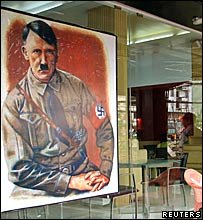Adolf Hitler’s “Mein Kampf” in India [by Sweet Travels]
While travelling in India, Simone and Mischa used platforms like couchsurfing, mainly to get to know local people. One thing that caught our eye and that we found irritating: Some couchsurfing profiles stated Adolf Hitler’s “Mein Kampf” in their favorite books. During our trip, we were often asked where we came from. When we said “Austria”, we often heard in response: “Ah, Australia.” When we explained that we were not from Australia, but from “Austria, Europe”, we heard now and then: “Ah, the country where Hitler came from.” Actually, Adolf Hitler was born on April 20th, 1889 in Braunau, close to the German border – 131 years ago.
We did some research on “Mein Kampf” by Adolf Hitler. First published in 1925, “Mein Kampf” has been re-edited numerous times since the death of the author. In Europe it is not just a book. It is a symbol, a historical source and it still triggers different reactions today. Adolf Hitler’s autobiography and Nazi manifesto is still sold today all over the world, under the counter, on the internet or simply at bookshops. It has been allowed to be reprinted in Germany since 2016. The Institute for Contemporary History Munich-Berlin reissued it – in a critical edition. In India, “Mein Kampf” can be found in bookstores alongside the biographies of Mahatma Gandhi and Steve Jobs. For Indian readers, Hitler’s manifesto is primarily a management guide.
Published by Jaico Publishing House in New Delhi since 1988, the book that outlined the political ideology of Nazi Germany, has found a new audience in India. The book’s anti-Semitic views don’t stop it from being embraced as a useful business model. Journalist Karan Singh asked Indian readers, what they learn from Hitler’s book. Some students told him that the book offers certain lessons: “In our country, we need more self-confidence. Hitler developed his country in a very short time through industrialization. Yes, he did have some bad qualities, so we can learn from his manners in style and leadership skills.”
Britain’s opponent was considered a friend
Adolf Hitler is considered a strong leader in India. A politician who transformed Germany on the ground after the First World War into a successful state with a hard hand. Many people in the South Asian country think that today’s weak, corrupt politicians should take an example from Hitler. Many Indians especially admire the National Socialists‘ economic policies. Hitler’s leadership qualities outshine his crimes here. Most Indians know little about Adolf Hitler and the Holocaust. Indian textbooks teach Europe’s history to a limited extent, the Holocaust is not much represented. An attempt to explain the book’s success in India goes like this: India had to fight for its independence from Great Britain – and the English were also Hitler’s enemies. Hitler’s “Mein Kampf” remains a book of paradoxes. RT New Delhi journalist Karan Singh says that “[i]t may seem strange to the rest of the world that this book is so popular in India. (…) With India, not directly affected by the Nazis, people here look at this book as just another piece of literature.”
The “Swastika” and/or “Hakenkreuz” in India
Some more observations Simone and I made in India: In the far east of the country we started our trip in India, and in the far west we finished it. In between we experienced the diversity of the country. Different food, different music, different languages, people and believes. We felt the diversity also in the nature: From snow-capped mountains to green regions, from desert regions to the coastal area. On our way through the country we saw the Swastika symbol almost everywhere.
In India, it is the “wheel of life” that also adorns many temples and statues. In the ancient Indian language Sanskrit, Swastika means “good luck charm”. The Swastika (or Sun Wheel) was originally one of the oldest symbols in the world. It has been used as a symbol of good fortune and hope by Hindus and Buddhists for over a thousand years, until today. When the Nazis came to power in Germany, they stole the symbol and it became the “Hakenkreuz”. The symbolism changed suddenly into hate, violence, genocide. The small difference in the representation is that the swastika stands upright while the National Socialists turned the wheel by a few degrees. The “Hakenkreuz” looks like it is sloping.
The decisive factor, however, is the completely different meaning that the Nazis gave to the Swastika or Sun Wheel. For the Nazis it stood for the Aryan race, an anti-Semitic-racist ideology. It had been the NSDAP’s party sign since 1920, and in 1935 it became part of the flag of the German Empire. The “Hakenkreuz” still stands for the ideology and crimes of the National Socialists. In Germany, Austria and other countries, the symbol is prohibited for political use – it may only be used for educational purposes.
Sweet Travels‘ radio contributions to India so far were on the “Beatles in India”, on “Meditation, Relaxation and Chanting in India”, and on “Theatre and Art in India”. All those editions can be heard here: https://cba.media/podcast/sweet-travels). The last edition of Sweet Travels is about the question, “What does wine from India taste like?” (May 10th): https://o94.at/programm/sendereihen/sweet-travels. Stay tuned!
Sources and information in German and English language:
In Indien ist Adolf Hitler ein Star – auch heute noch (Welt, Sophie Mühlmann ): https://www.welt.de/politik/ausland/article160191205/In-Indien-ist-Adolf-Hitler-ein-Star-auch-heute-noch.html
Hitlers „Mein Kampf“ (Planet Wissen): https://www1.wdr.de/mediathek/video-hitlers-mein-kampf-100.html
Face of Evil or Management Manual? ‚Mein Kampf‘ a best seller in India (RT New Delhi, Karan Singh): https://www.youtube.com/watch?v=lW99XGniAOo
Hitler’s ‚Mein Kampf‘ makes a comeback as a bestseller (CGTN, Guy Henderson): https://www.youtube.com/watch?v=gqr1zSUKYfg
Indian shop called Hitler: https://www.youtube.com/watch?v=87FcZWKs5Y0
Feature: Wohin steuert Indien? Der hindu-industrielle Komplex: https://www.youtube.com/watch?v=O1huaLqd6Nk (WDR/Dlf, Dominik Müller, Susanne Krings, Ulrike Bajohr)
Mein Kampf: The Secrets of Hitler’s Book (Documentary, Java Films): https://www.youtube.com/watch?v=48G0VsIdsN4
Nationalsozialismus – Swastika / Hakenkreuz (GRA): https://www.gra.ch/bildung/gra-glossar/begriffe/nationalsozialismus/swastika-hakenkreuz/
Woher kommt das Hakenkreuz? (Zeitklicks, Sabine Gruler): https://www.zeitklicks.de/nationalsozialismus/zeitklicks/zeit/propaganda/im-ganz-normalen-leben/woher-kommt-das-hakenkreuz/























Super Beitrag, Danke !!!